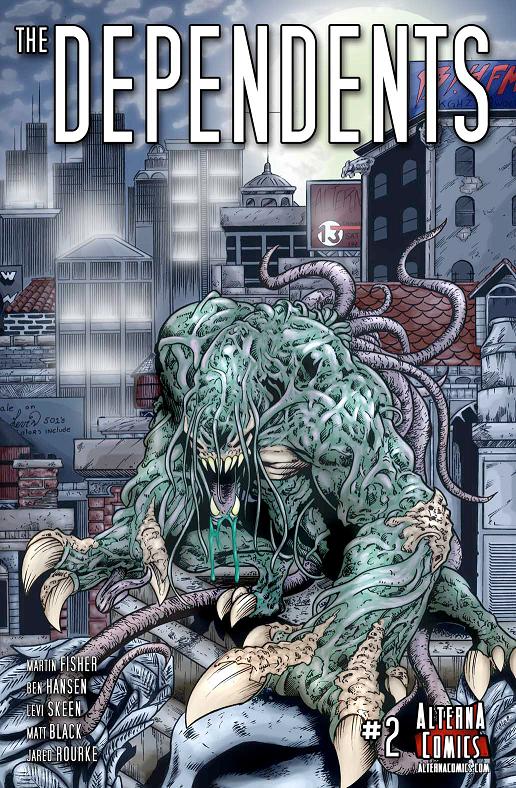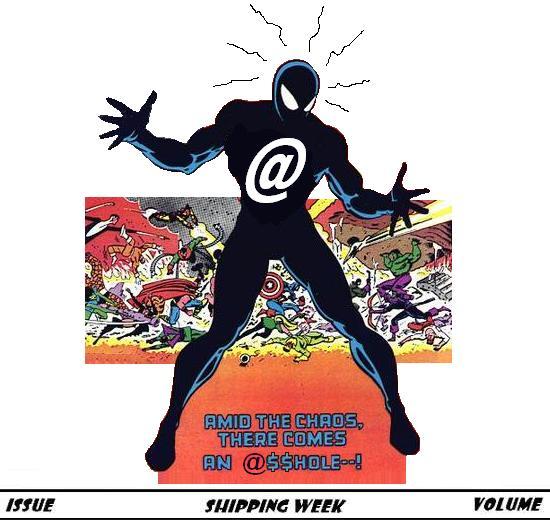
| #5 | 6/4/08 | #7 |
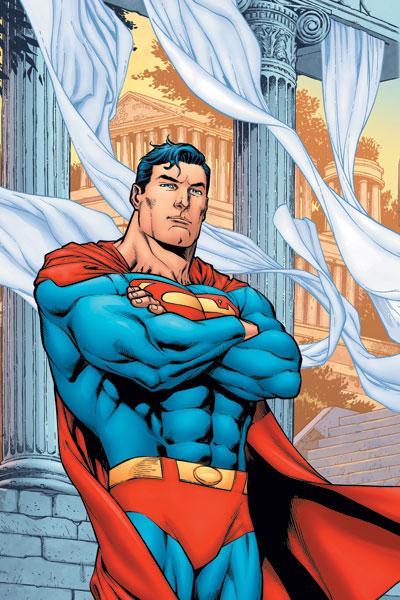
TRINITY #1
Writer: Kurt Busiek Art: Mark Bagley (pencils) Art Thibert (inks) Back-up story writers: Kurt Busiek & Fabian Nicieza Back-up story art: Scott McDaniel & Andy Owens Publisher: DC Comics Reviewer: Ambush Bug
Although COUNTDOWN was an awful and boring mess, I'm willing to give DC's new weekly title a shot and after reading the first issue, I still am. Most of this has to do with the creative team behind this weekly series. Kurt Busiek has proven himself to be a powerful writer with his AVENGERS run and JLA/AVENGERS miniseries (two titles that I hold near and dear to the dark, black hole where my heart resides). His stories almost always resonate with me and he seems like a comic book writer who actually appreciates and revels in the history of comics. In the art department, Bagley is rock solid and strong. He's never been an artist that makes my jaw drop in awe, but when it comes to straight-forward, clean n' clear, dynamic panels and action, he's definitely the man to go to. So going into this, I didn't have the highest expectations given the lock-jaw recovery I'm going through from the recent yawn-inducing ending of COUNTDOWN, but I was interested. Wary, but interested.Turns out this is a promising first issue, albeit a bit short and breezy. Busiek doesn't play all his cards in this one, and I guess he doesn't have to given the weekly format and the fact that he has a year to tell his story. But the comic moves along at a respectable pace, setting up a situation that calls for the intervention of the Top Three heroes of the DCU. It peppers in some interesting moments, gives us a cameo by the Flash aaaaaaaaaaannnnnd we're done. If anything, this issue moved along at an all too brisk pace for me. If not for the back-up feature, I would have been complaining about lack of content.
But there was content here. Bruce Wayne, Diana Prince, and Clark Kent meet on a "secluded" restaurant on a pier and discuss a dream they are all having. Something big is in the rumbling stages, and after a nice action scene with the Flash, his kids, and Clayface, we find out that the Holy Trinity of the DCU are the only heroes having this dream. Again, and I know I'm repeating myself here, stuff happened, but it still felt a little light. And that's where I guess my criticism of this book starts.
You see, when you have fifteen pages to tell your story, I would think old pros like Busiek and Bagley would want to fill the whole damn thing to the brim. Especially in the first issue where you’re really trying to sell the book. Now, this is no 90's Image poster book or a Quesada-drawn comic, folks. Don't get me wrong, but there are an awful lot of large panels and splash pages for fifteen pages. 3 splashes make up a fifth of the story, though. On top of that, Bags offers some pretty page consuming images of banality like Wonder Woman making her first appearance in street clothes (it's not like we haven't seen Diana in a smart white suit before). I don't want to scream trade-pacing or space-wasting in order to fill the allotted pages just yet, but it's something I'm going to keep my eye on.
Time to pick nits.
Sure, a meeting of the super powers of superhero-dom is cool. It's always fun to see strong personalities bounce off of one another. That's one of the main reasons why people are going to want to buy this book. But it was just established in the last issue of JLA that a room in Hyperspace was constructed by Green Lantern for secret Illuminati-esque meetings between the Big Three. Why risk their secret identities by sitting out in broad daylight together, especially at a trendy spot that, as the caption reads, "THE KEYSTONE COFFEE PIER. A popular morning destination along Keystone City's revived riverfront, and more and more, an essential weekend spot of the young, noteworthy, or want-to-spot-someone-noteworthy to see and be seen..." The locale just doesn't match up, especially when the conversation is about keeping a low profile and upholding secret identities.
Nit #2 has a larger scope. The reason why I stopped buying SUPERMAN/BATMAN, other than the horrible art and bad writing, was that I knew that no matter what the threat, nothing of consequence would really spawn from that book. It's not like Batman or Superman are going to die. It's not like Bruce is going to lose an arm or Lois would end up paralyzed. Nothing earth-shattering can happen because that's not their main book. And even if something of great relevance occurs, it's the DCU, so that means that it's probably a parallel timeline or alternate Earth. When these stories lack relevance, I usually tune out. There's too much riding on these characters; movies, multiple titles, merch. Nothing really huge can happen to them. Sure that pretty much describes a lot of the characters in the DCU, but these three especially. And the result, in the past, has been some pretty bland storytelling. Even the cliffhanger at the end of this issue can be solved simply by Superman flying out of the way of falling debris. Not really a nail-biting situation presented here.
Now that's not so much a criticism (well, it sort of is), rather, it's a challenge to the creative team behind this book. So far we've got a snippet of a life threatening crisis (oops, sorry, used a naughty word) on the horizon. Now it's time for Busiek to make this story count in some way. It'll take some strong storytelling to do that and I know Busiek has it in him. These three are the most recognizable icons of DC. Because of that they are also, most of the time, the most boring. How many times have we seen Batman and Superman at odds? How many times have writers tried to secure Wonder Woman's place in the top bracket when the character has struggled for some kind of distinctive identity for years? Busiek's job is to shatter the malaise that accompanies these three safe heroes. If anyone can do it, it's this guy.
Bagley's art is strong in this book, but other than the Flash fight, Busiek doesn't really give him a whole helluva lot to do. I'm sure future issues will be able to highlight his vibrant art much more effectively. Again, I have high hopes, but not a lot was shown in this issue to cement these hopes as real.
The back-up feature was fun. It introduces a few new and old characters and sets up a trio of villains to match our heroes. One looks mysteriously like the Riddler and is even referred to as Enigma (E. Nigma, the Riddler's real name). The main voice of the story, provided by main baddie Morgaine Le Fey, does get a bit fanboyishly obsessive when she tries to gather troops in her fight against the Big Three. You’d think she’d want to load up on villains to overpower the trio, not just come up with villains that compliment the heroes so accurately and evenly. Scott McDaniel is one of those artists that people either love or hate. I think his art is dynamic and does a great job of suggestion motion and action. A few panels of this back-up look a bit rushed, but for the most part he turns in a solid job.
The thing about this back-up feature, though, is that for a page, it focuses on a world without Batman, Superman, and Wonder Woman, where Green Arrow and Speedy are challenging Ragman and a sidekick to be Protectors of Gotham City. That got me thinking. What if, after the big Bats/Supes/WW adventure is over, TRINITY continues as a THE BRAVE AND THE BOLD type book where three heroes team up to make an instant team for an issue or two. It'd be cool to see Green Arrow, Aqualad, and Detective Chimp have an adventure together. Or Guy Gardner, Hawkman, and Uncle Sam. The trio would shift and change given the circumstances. Sort of like those old DEFENDERS issues where a hodge-podge of heroes ban together for a single adventure, then go their separate ways. But there I go giving DC ideas for free again. It's just something that popped into my head while reading the last few pages of the book.
Enough dreaming. TRINITY #1 is definitely worth checking out for an issue or two to see if it’s up your alley. I wish the price tag was a bit lower, but that's not going to stop me from checking it out, given the creative team. But aside from hope for better issues to come and an appreciation for the creative team behind it, I have to say that this issue fell a bit short as far as introductory issues are concerned. A first issue these days has to knock it out of the park. This was a team of homerun hitters stepping up to plate, and then bunting. Hopefully, more will occur in the next issue and the creative team of Bagley and Busiek will live up to expectations.
Ambush Bug is Mark L. Miller, reviewer and co-editor of AICN Comics for close to seven years. Look for his first published work in MUSCLES & FIGHTS 3 (AVAILABLE NOW!) from Cream City Comics.
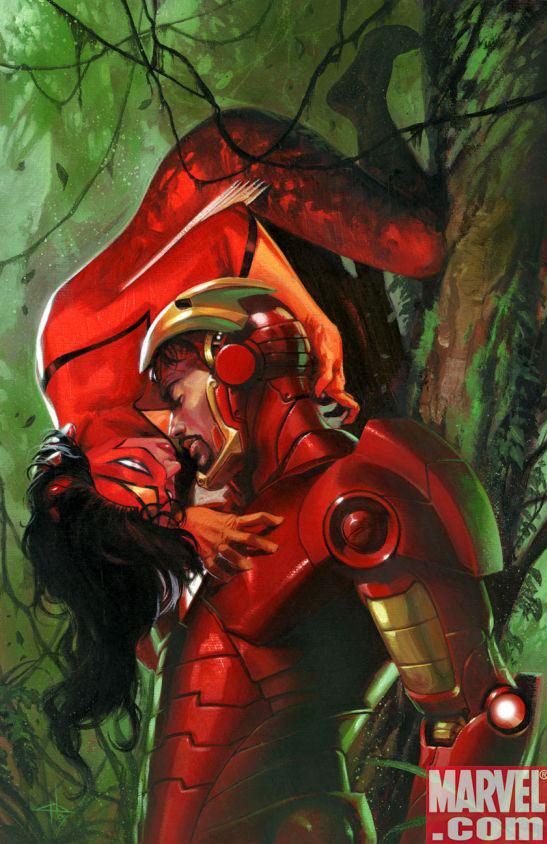
SECRET INVASION #3
Writer: Brian Michael Bendis Art: Leinil Yu (pencils), Mark Morales (inks) Colors: Laura Martin Publisher: Marvel Comics Reviewer: Rock-Me Amodeo
So now I know the drill: the background stories are in the AVENGERS titles, while the meat is here. Now that I know the ground rules, I’m liking the whole event a lot more. And that means this is really the series to watch. Since we’re both here, let’s get into it.First of all, I have to give Yu his due. I know I’ve ragged on him in the past for his tendency to draw feet of Brobdingnagian proportion, but he really seems focused so far. Morales is also doing a bang-up job inking, and brings a crispness I found lacking when Yu inks himself. Gone are the millions of hashlines that used to obscure his magnificent blocking. Everything was nice, and a few panels…like that one clear picture of Jessica Drew, when we first see her…edged on breathtaking. She’s removed her mask so we can see her face, and that face is so stunning, and Yu showed such restraint in not over-drawing it…well, needless to say, I’m digging the art.
Also, a tip’o the hat MUST go out to the stunning colors of Laura DePuy Martin, who brought PLANETARY to life and was most recently seen on the ASTONISHING X-MEN run. This is one woman who knows her craft. She didn’t get those Eisners for nothin’.
Regarding plot: the Super-Duper Skrulls are taking on all comers, from the Young Avengers to the Initiative. Meanwhile, we’re thrown a red herring or two as Tony Stark grapples with the fact that he may or may not be a Skrull. But Jessica’s eyes are green, and Tony’s are not, and given the fact that it makes perfect sense that his IS a Skrull makes me think he’s not. You follow?
Plus, and I believe this, I don’t think they CAN duplicate intellect. Knowledge maybe. But not ingenuity. Not intuition. Certainly not wisdom, which comes mostly from experience. But if the Skrulls had memories laid into them, then they kind of DO have experience, or at least the memory of such.
So Iron Man is…well, I really dunno. Let’s see how this plays out. And meanwhile, we’ll get to see what Nick Fury and his non-Howling Commandos can really do in a firefight.
Neat and odd little touches: when Vision is blasted through the back of the head, the scene is being played out on the big screen above his head. Earlier in the town battle, the theater marquee reads “Sam Kinison.” I have no idea what THAT means, but it certainly qualifies as neat and odd. The surrender terms of “Jarvis.” And the battle on Thunderbolt Mountain. I have no idea what that added to the story per se, so it was more odd than neat.
Overall, thought, it was the first book I wanted to read, and I didn’t want it to be over when it was. That’s always a good sign.
Dante “Rock-Me” Amodeo has been reading comics for thirty-five years. His first novel, “Saban and The Ancient” (an espionage/paranormal thriller) was published 2006. He began writing for AICN Comics in 2007 and his second novel (“Saban Betrayed”) is due 2008. He’s often told he has a great face for radio.

MANHUNTER #31
Writer: Marc Andreyko Artist: Michael Gaydos Publisher: DC Comics Reviewed by: BottleImp
Let’s face it: there are only so many variations that can be done on the superhero archetype before repetition becomes mandatory. Sometimes a new element is added to a character’s origin or personality that can tweak the familiar “great-power-great-responsibilty” type or the “grim-vigilante-avenging-personal-loss” type of hero into something… well, if not new, then at least far enough removed from the archetype so as to be interesting. Such was the case with DC’s latest incarnation of Manhunter: in the manner of Daredevil we have Kate Spencer, a lawyer who decided to don a costume and hunt down criminals who slipped through the loopholes of the law. But here’s the key difference: Spencer is a federal prosecutor without any special powers or abilities who raids the evidence lockers for her costume and weaponry, hunts down Copperhead (the latest mass-murdering supervillain to escape justice), and KILLS him, crossing the line that few heroes (at least until the grim ‘n’ gritty ‘90s) ever cross.And the new Manhunter is also…kind of a bitch. Caustic, chain-smoking, a divorced mom who doesn’t seem to really care about her kid—one of the first superheroes in a long time whom readers could really see as a “real” person (kind of like when Peter Parker first appeared and Stan Lee ushered in the era of “realistic” comic book characters). These traits are what got me hooked on MANHUNTER. You didn’t really like her, but you still rooted for her. But after awhile, the series began to shift. Kate Spencer started becoming more likable, her relationship with her son and ex-husband got better, more and more focus was given to her supporting cast, and the initial draw of a hero dispensing final, brutal justice to the guilty was never to be repeated. MANHUNTER’s defining edge had been dulled. I continued buying the series through its cancellation at #30 more out of habit than anything else, sure that the promise given of MANHUNTER’s return would not come to pass. But I was wrong…
…and I have never been so glad to be wrong.
In an interview with our own Ambush Bug a few weeks ago, series writer Andreyko compared MANHUNTER to James Robinson’s excellent STARMAN, and I think the comparison is apt. Like Robinson, Andreyko has a definite character arc that he wants to follow, and has also spent a lot of time building his title character’s supporting cast into a fully rounded group of men and women who each have their own stories and paths to follow. And just like STARMAN did for a while, MANHUNTER fell into a doldrums of meandering around these supporting players for too long while the main character was left idle. Thankfully, the series returns with a bang and puts focus back on Kate Spencer, throwing her into the middle of a mystery surrounding the deaths and disappearances of hundreds of women on the US/Mexico border. Her personal life is also shifted from the comfortable nest we saw Kate in back in #30 as her grandfather, Iron Munroe, comes into her and her son’s life. Kate is deeply unsettled by this for reasons she can’t explain—bad for her, but great for the series.
New artist Michael Gaydos is an amazing match for the book; his stylized realism and fantastic handling of light and shadow perfectly complement both the characters and their world. This is not the four-color universe of Superman or the Justice League—MANHUNTER is set in a world much closer to our own. It’s grim ‘n’ gritty without being annoying or clichéd about it.
If you were a fan of MANHUNTER when it first hit the stands, you’ll love this book. If you weren’t a fan back then, you’ll still love this book. And if you’re sick to death of Crises, Invasions and Crossovers, you’ll DEFINITELY love this book.
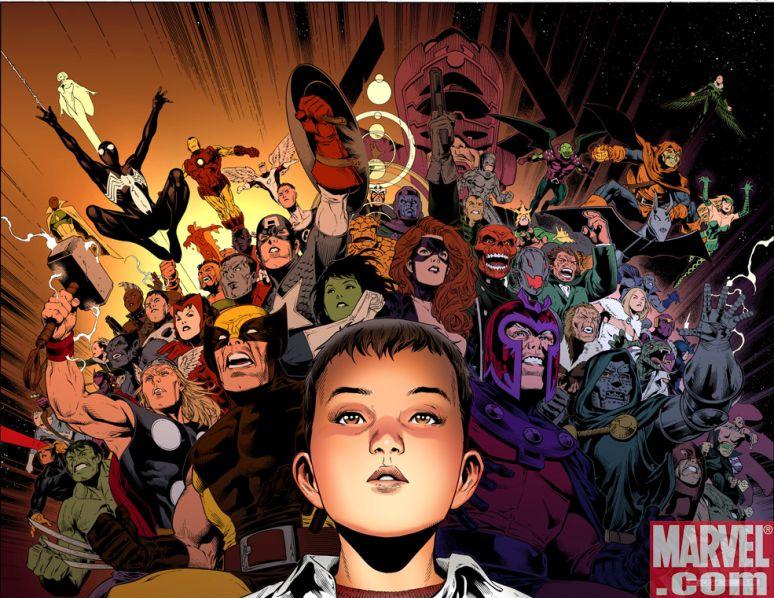
1985 # 1
Written by Mark Millar Art by Tommy Lee Edwards Published by Marvel Comics Reviewed by Stones Throw
First things first: this is another great high concept from Millar. The guy’s strength is definitely in big, easily-graspable ideas that strike you with why didn’t they do that before? -- usually followed by well, isn’t that kinda like… -- and this one doesn’t disappoint. Marvel heroes and villains making their way into our world, as seen through the eyes of a young comic book-reading kid who fans like us can probably relate to. Millar seems to be taking his cues from kid-centered movies like E.T. or THE GOONIES with his story of an unhappy kid (his parents got a divorce) and his best friend who are alone in thinking there’s more than there seems to the guy on the local news dressed as the Vulture, and as a result the book feels refreshingly different from the rest of Marvel’s output at the moment. I like the way emphasis is placed on the suspense/creepiness angle, with the abandoned house outside of town and the mysterious creatures in the woods, rather than the usual superhero stuff.A lot of that’s down to artist Tommy Lee Edwards, who draws forests and crumbling old houses just as impressively as he stages a conversation between Doctor Doom and the Mole Man. A scene where a lone kid happens across a meeting between villains is pretty rote, but Tommy Lee made me feel the tension. The book wouldn’t work without a reality-based eye like his, although I think I preferred his work in NO COUNTRY FOR OLD MEN. That or his drumming.
I suspect Millar might believe the opposite, but I found this to be a much more grounded read than his other current Marvel mini, KICK-ASS, which is covering similar ground what with alienated kids and superhero fixations. With KICK-ASS I kind of liked the gonzo audacity of the violence and improbable character motivations, but it’s a lot easier to buy these guys as real people. Maybe because Millar sits back and lets the characters reveal themselves a little more than dictating who they are in the narrative boxes. I liked the way that characters like Toby’s best friend and his father work their way into the course of the story naturally rather than being specifically introduced to the reader.
Now onto what wasn’t so good. For a book that’s all about evoking the real world atmosphere of 1985 and then juxtaposing that with the addition of superheroes from the Marvel universe, I didn’t really feel the period and place. This is probably where having a Scottish writer who bought all his Marvel comics either as imports or British reprints (see my write-up last week!) is a handicap. The details didn’t quite ring true. We all know that DAZZLER, Frank Miller’s DAREDEVIL, CEREBUS, LOVE AND ROCKETS etc. were popular at the time but, kinda like the clunky comic book conversations in KICK-ASS, the references feel a bit more like name-drops for modern audiences than a conversation a 10-year old kid might actually have with his comic store proprietor. I could be wrong, but I think it’ll probably take personal experience to make the setting live when you’re trying to write real world sort of stuff. Maybe Millar should have written about a pre-pubescent, comic book-collecting Scottish kid.
Also, I get the sense that, once again, the blockbuster high concept is leading the way for Millar here. I stand by what I said about the premise being an automatically cool one, but I think that that good idea causes Millar to skimp on the character work a little. The characters are a little too incidental to really matter. How many times have we seen an unhappy kid like Toby have some kind of brush with the fantastic? Or conflict between a well-meaning but unreliable dad and his son’s put-upon mother? Millar doesn’t do a lot of work to add anything unexpected to the mix, and as a result, if you know the premise, there’s not gonna be a lot of surprises here.
Still, the main hook and Edwards’ art are strong enough to have me back for at least another issue, in which I’d like to see Millar deviate a little from the formula it looks like he’s following. He seems to be pretty steadily on his way down the Spielbergian wonder/schmaltz path rather than any attempt at the kind of Morrisonian meta-fiction/genre-bending that this kind of idea might invite, but you never know.
Cool idea aside and all, I’ve got to wonder what the incentive is for the Red Skull, Doctor Doom and the Hulk to be hiding out in an abandoned house in upstate New York, or wherever it’s actually set (the book doesn’t say). I mean, there are villains that might stand to gain something from leaving the Marvel U. Two not-very-memorable kids versus the Grizzly, Stilt-Man, Plant Man and Mister Fish could be an equally cool, totally different miniseries.
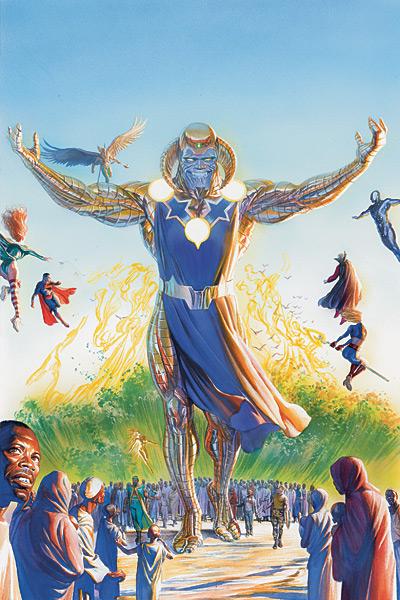
JUSTICE SOCIETY OF AMERICA #16
Writer: Geoff Johns with Alex Ross (story) Artist: Fernando Pasarin Publisher: DC Comics Reviewer: Optimous Douche
”Never trust a God with a shit eating grin.”While certainly not a morality tale one would expect to hear spewed out by a pent up penguin in catechism class, this is generally a good rule of thumb when it comes to comic books, especially when the God in question was once a petulant douche of epic of proportions on an alternate world.
Johns continues his homage to KINGDOM COME in this latest installment of JSA by transcending the rabble rousing antagonist of that title Gog/Magog to deity status and in the process does one of the finest tie-ins to date pertaining to the concept of a “new age” at DC. I would even be as bold to say that references made in this issue were far more cohesive and understandable then anything in Crapdown or FINAL CRISIS.
Even though this marks the beginning of a new story arc for JSA, it feels like a fluid continuation of the last story arc. This title has been a true event, sans all of the marketing hype and cross-over bullshit that is usually thrust upon the shelves of our LCS. This fluidity serves as a great strength for those of us committed to reading anything that oozes from Johns’ brainpan, but could be detrimental for new readers or those that require testicle tightening thrills to stay glued to the page. This story won’t make you eek with girlish glee, but it was well crafted, and once again Johns harnesses his unique ability to make third-string characters of the DC Universe interesting.
The kick-off narration by Damage recounting his origin served as a great piece of personalizing juxtaposition to offset the later told origin of the New/Old God that was once asshat Gog/Magog. Plus these opening panels made me care about a character I have barely noticed in past issues. I will chalk up my lack of observation to either Juvenile Alzheimer’s disease or the fact that the JSA roster now includes every DC original hero, their progeny, and…well fuck, it’s easier to say anyone who is not on the Justice League (seriously guys, cut back on recruitment for a bit, I don’t want to see a super team have the need for an HR department despite the Dilbert-infused comic potential). Even though I knew nothing about Damage, in just about two pages I was whisked from his pathetic paternity, to his apocalyptic mistake in Atlanta, and finally to his existence as a man without a face. To grow empathy for a character in two pages is tight writing at its finest. In a medium with only twenty-two pages of fodder, this is a virtue not to be overlooked.
I’m on the fence about Gog God. I loved his whirlpool origin and the tie in to the 52 universes. I also appreciated the dichotomy of him being a peaceful creature while Pasarin makes his physical appearance akin to my worst nightmare giant sized. And I truly loved the apprehension by some of the JSA who recognize this dichotomy. I guess I’m bothered by where this will go. To make him pull a 180 next issue and go from peace bringer to oppressor would be fun but predictable. On the other hand, the dude is borderline retarded right now. If he stays this nice, naïve and monosyllabic I will half expect a line where he asks Becca…and…Tyler if he can go to the dance with them on Friday…oh bla de oh blah dah.
This was a great book in what has been a great series, but Johns has work cut out for him in the next few issues. Severing the umbilical ties to KINGDOM COME will be inevitable if this book is going to progress, but a virtual impossibility with Celebrex Superman on the roster. Also, I really need someone, somewhere, to flesh out this third, fourth or whatever age of Gods. Here is as good a place as any.
Oh, and as a special treat for reaching the end of the review ---- Black Adams returns, and it is indeed awesome. Thank you Isis for dropping dead and once again emotionally scarring my most favorite good/bad guy of all time.
When Optimous Douche isn’t reading comics and misspelling the names of 80’s icons, he “transforms” into a corporate communications guru. Optimous is looking for artistry help, critical feedback and a little industry insight to get his original book AVERAGE JOE up, up and on the shelves. What if the entire world had super powers? Find out in the blog section of Optimous’ MySpace page to see some preview pages and leave comments.
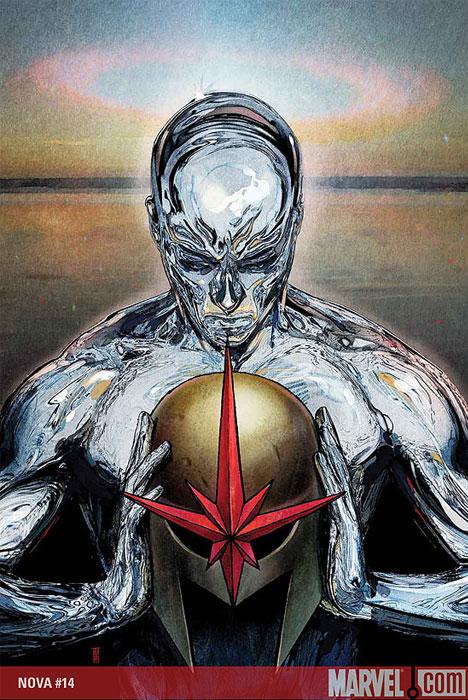
NOVA #14
Writers: Dan Abnett & Andy Lanning Art: Wellington Alves (pencils), Scott Hana (inks) Publisher: Marvel Comics Reviewer: Rock-Me Amodeo
Familiarity breeds contempt. Or at least, in many cases, apathy.I remember watching magic shows growing up and wanting to do the same. What were the secrets? How did it all work? Once I got my first little magic kit, however, it was a different story. So THAT’S where the little ball goes. Oh, they’re TRICK cards. And pretty soon, my enthusiasm fizzled.
Forty years ago, Galactus was a show stopper and an instant sales boost. But over the years, as he became better known, he dwindled in mystery and majesty, to the point where a human-sized Galactus could be seen chatting up Reed Richards on the streets of Manhattan, looking for some quick legal advice, a shower and maybe a change of clothes. You could say I got Byrned-out on the character. The thrill was gone.
This issue of NOVA brought it back. Oh man, did it ever! Even the Silver Surfer (who pre-dates wussified “emo” culture by a couple decades) turned in a ballsy badass performance that still managed to show he has a heart. But his heart is beating underneath his ribcage, where it ought to be, instead of bleeding on his sleeve so prominently that even a blind sculptress could see it.
And who was the comic about again? Oh yeah, Nova! I know, it may look like I’m ignoring him. But I wanted to dally some with the supporting characters because what they REALLY do is act as a foil, showing just how cool and powerful Nova is. Even as this issue establishes that the full power of the Nova Corps is still not much against the Power Cosmic, it shows that Nova is VERY resourceful and commanding even against overwhelming odds.
I LOVE the fact that Nova is so far beneath Galactus that he’s almost beneath the Surfer. I LOVE the fact that Nova KNOWS the Surfer may well hand him his head. So I LOVED the scene where Nova turns around and DECKS the Surfer anyway. What a great set up to that scene.
And Alves’ art is nothing short of fantastic. The images of Galactus’ face, looming in the background with starfield shadows…just awesome.
Some characters should always be a mystery. I think the Surfer and Galactus are two of them. They are magnificent props, and should be used as such. I’m glad the same cannot be said of Nova. The more I see him display his bravery, his authority, his occasional (but not overriding) hotheadedness and the camaraderie he has with the Worldmind, the more I want to see.
Great issue on all fronts. With current creative teams leaving AXM, THUNDERBOLTS and IRON FIST, this is now Marvel’s benchmark comic.
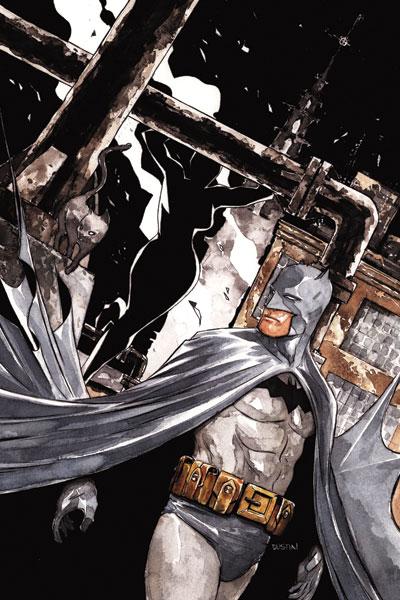
DETECTIVE COMICS #845
Writer: Paul Dini Penciller: Dustin Nguyen Publisher: DC Comics Reviewed by Humphrey Lee
I've had a sort of "Love/Kind-of-Like" relationship with DETECTIVE COMICS ever since that rapscallion Paul Dini has taken over. While I've yet to read anything I'd ever quantify as bad or below average from the man, the myth, the legend, some of the stories from this run have left me kind of indifferent. I don't know if it's a genuine dislike I have of one-and-done storytelling or what. Part of me thinks it is, because I think it's rare that anyone can pull you through the setup, the action, and the climax and leave you feeling like you saw a perfectly fleshed out story in just twenty-two scant pages. But then again, whenever an issue of FELL happens to grace the stands it's almost always my favorite thing in that week's stack and with less pages than normal to boot. But, when I get to thinking of the best stuff in this run of Dini and crew, it's almost always the multi-parters that come to the forefront. Hell, I was just praising this title a few weeks back with this last Zatanna twofer, and here I am saying it's back in the realm of "pretty good". Maybe I just don't know what I want...In the case of this issue, I guess what irks me is that this was one of those types of murder mysteries that I, as the reader, have no chance in hell of figuring out. Sure, chances are I'm almost never going to figure out exactly who did what and why in any sort of murder mystery because if I could, well, then it's probably not a very good one. But at least up until the reveal you always have an idea as to whom the culprit is, mistaken as it might be, so when the final reveal hits you point and yell "OH! THAT GUY!!" and then find a new appreciation for the way the story was told. But when I hit the halfway point of this issue (which I want to address in a second) I knew this was one of those kinds of stories just by the way it was developing and it kind of took me out of the whole piece.
Now, that said, there was still a lot of really fun stuff here which is why despite my disappointment at the overall plot of the issue, it was still overall pretty entertaining. Firstly, I'm always highly enthused to see Dini's new and reformed Riddler. He's such a smug bastard, but the way Dini uses him to chew up scenery is oft times excellent. Secondly, Batman on an Internet Chat Room has to be one of the most surreal things I think I've experienced in my comic book reading career. As soon as the idea was presented I absolutely cringed, but as the situation grew to involve the likes of Detective Chimp and the aforementioned Edward Nigma it was pretty fun in a farcical kind of way. Thankfully, there was no LOLing on the part of the man in the cave. That I think would have been a case of going too far. And even though the "reveal" was pretty whatever, the purpose it served towards reminding us what kind of damage a character like the Riddler can cause on an personal basis to those he encounters was poignant enough.
I'm not exactly sure what the purpose of dedicating three pages to the Catwoman re-emergence was (as depicted on the cover) as pertains to this issue, but I assume it was just them getting it out of the way in order to establish that she'll be making some rounds in this title later on. All in all though, like I said earlier, this was another solid issue altogether. I guess up next I'll be getting my wish for a more extended arc, but at the same time it's apparently time for this book to become R.I.P. involved which fills me with no limit of joy... actually, apparently that's sarcasm. I think I'd rather just have the one-and-dones instead, but I guess if anyone's going to make this tie-in interesting, and one involving Hush at that, it would be Dini and Co.
Humphrey Lee is a long time AICN reviewer and also a certified drunk whose claim to fame is making it up four steps of the twelve step program before vomiting on steps five and six and then falling asleep on steps one through three. Also, chances are, he's banged your mom (depending on the relative hotness of said parental figure) and is probably the father of one of your younger siblings.
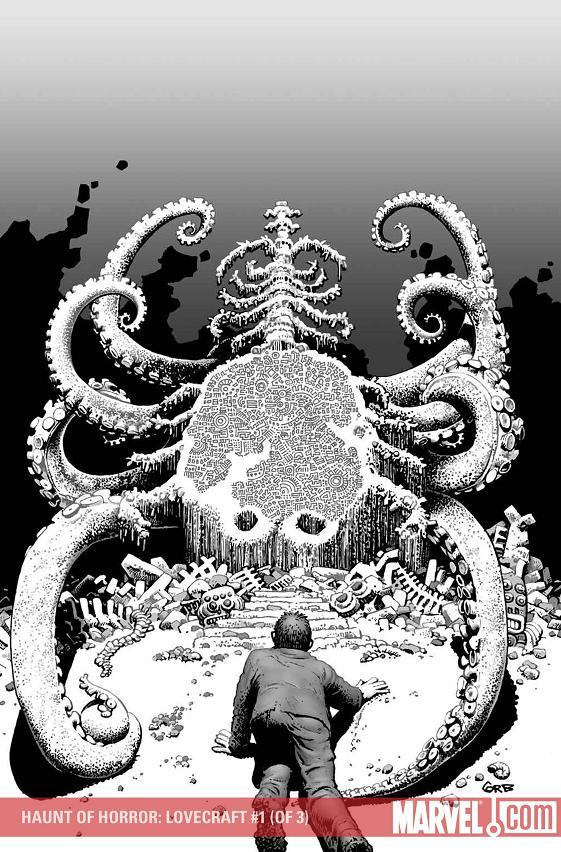
HAUNT OF HORROR: H.P. LOVECRAFT # 1
Adaptations by Richard Corben Publication by Marvel Comics Reviewing by Stones Throw
I was planning to review this with Vertigo’s second issue of HOUSE OF MYSTERY (HOUSE OF MYSTERY / HAUNT OF HORROR, geddit? Woulda been great) but to my horror, and even, one might say, mystification, upon arriving at my local comic store I found that they’d already sold out of HOUSE OF MYSTERY. This told me two things: 1) Vertigo’s new series must be pretty popular around here; and B) a double review was all but impossible. So, here it is: a lone review of H.P. LOVECRAFT’S HAUNT OF HORROR, as adapted by Richard Corben, published by Marvel MAX and reviewed by your friendly, neighborhood, HOUSE OF MYSTERY-less Stones Throw.HOH: HPL is a sequel to 2006’s HAUNT OF HORROR: EDGAR ALLEN POE, another three-issue miniseries presenting three shorts (each around ten pages) per issue written and drawn by Corben and this time inspired by short stories or poetry by everyone’s favorite Cthulhu-worshipping nutjob. Issue one serves up “Dagon”, “The Scar” and “A Memory” (the credits/contents page mixes this up, putting “The Scar” and “Recognition” as the first two stories, when in fact they’re alternate titles for short number two).
HOUSE OF MYSTERY, by contrast, didn’t bother with a single story.
First up in HAUNT OF HORROR is “Dagon”, a timeline-twisting story about a scientist who’s shipwrecked by a German sea raider and washes ashore on an island populated by “damnably semi-human” amphibians. Were those things ever creepy. Human-shaped fish piling dead bodies up as an offering to something bad is one of the scarier sights I’ve seen in a comic book recently. This is the cover story and Corben’s art lives up to that cover’s trippy promise. He uses bigger panels to build a sense of dread with the intricate carvings on that giant throne than for the entrance of one of Lovecraft’s giant “Nameless Ones”, but it still has all the power of at least a dozen splash pages.
Turning the page, the next feature of the book is a reprint of Lovecraft’s original “Dagon” story. I suppose I shouldn’t quibble with the extra content but I felt this undercut some of the mystery of Corben’s adaptation, making it seem more of an artistic exercise in translating a Lovecraft story into sequential art (which I suppose it is) than a work of art in its own right. It seems a bit like saying “now we’ve got the comic out of the way, here’s the real story”. While this was only a problem for the brief moment when I turned the page, it could probably have been avoided if more of an effort was made to make it a part of the comic (as it is, it’s typed text on a blank white background) or if it was placed at the back with the two poems, as more of a DVD extra than the key to the puzzle of the adaptation.
HOUSE OF MYSTERY, meanwhile, had no such sequencing problems.
The remaining two shorts are adapted from poems from Lovecraft’s FUNGI FROM YUGGOTH. Disappointingly, neither featured mushrooms who are good party people. Despite this oversight both were just as good as their predecessor. It looks like Corben does away with the interconnectedness of Lovecraft’s sonnet sequence to focus on putting his own spin on the source material. “The Scar” had Corben’s freakiest art with giant, rotting tree monsters terrorizing a young kid who refuses to help out a fellow lost human being and a cool twist in the tail. “A Memory” gave him the most opportunity to flesh out a fairly abstract poem and it was the most original of the bunch, focusing on human carnage over supernatural ghouls. The gore was rendered with lovingly hard-edged detail.
I didn’t really notice HOUSE OF MYSTERY’s art.
I recommend picking this series up for some summer horror kicks. The combination of Corben’s black and white art and the text pieces kind of reminds me of the Marvel horror magazines reprinted in my ESSENTIAL TALES OF THE ZOMBIE paperback. Either way, H.P. Lovecraft is a distinctive horror voice and Richard Corben is a true comics original. I’m looking forward to the next two issues, and it was a damn sight better than HOUSE OF MYSTERY.

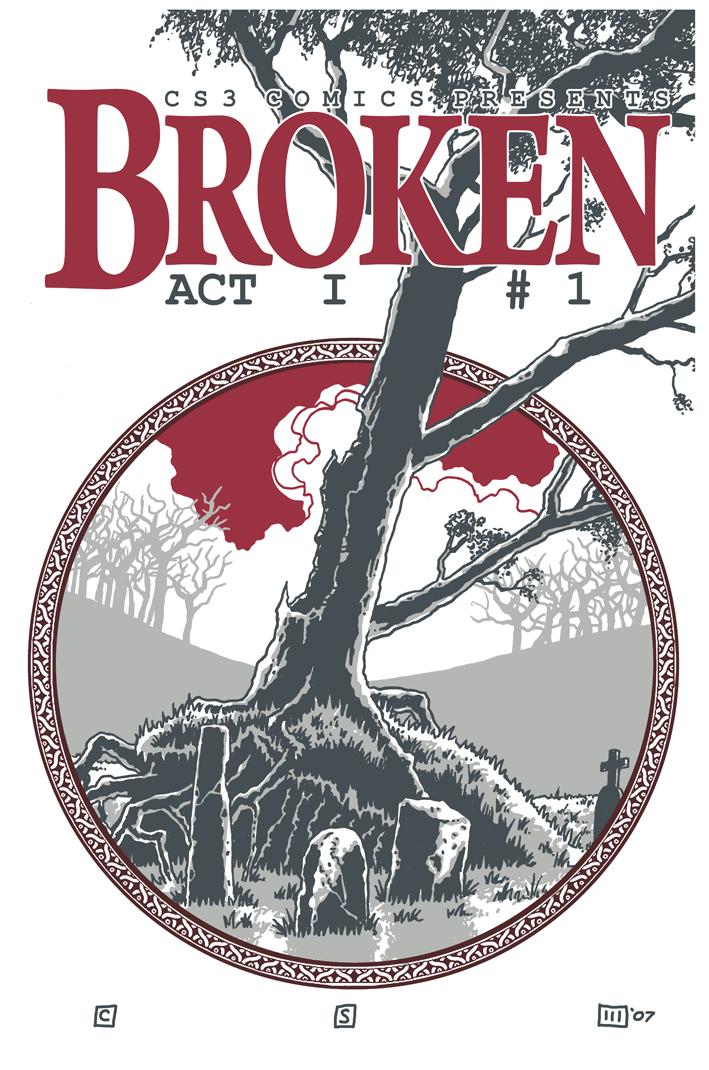
BROKEN THINGS Webcomic
First page can be found here. By Chip Skelton Reviewer: Ambush Bug
Here’s another offering from Drunk Duck, which is leading the pack as an online comics community. I can’t say that BROKEN THINGS is a fun read, but it doesn’t seem to want to be. This is a somber tale about a lonely guy who talks with his mother’s tombstone, tries to stay out of trouble with a nosey sheriff, stay out of the way of his abusive father, and put up with everyday teen life like bullies, girls, and failing miserably at fitting in. The story moves slow and new tiers (panels) are added one at a time, which adds to the leisurely pace, but this isn’t a story of WHIZ! BANG! Action. It’s a story about slowing down and appreciating the quieter moments in between the chaos.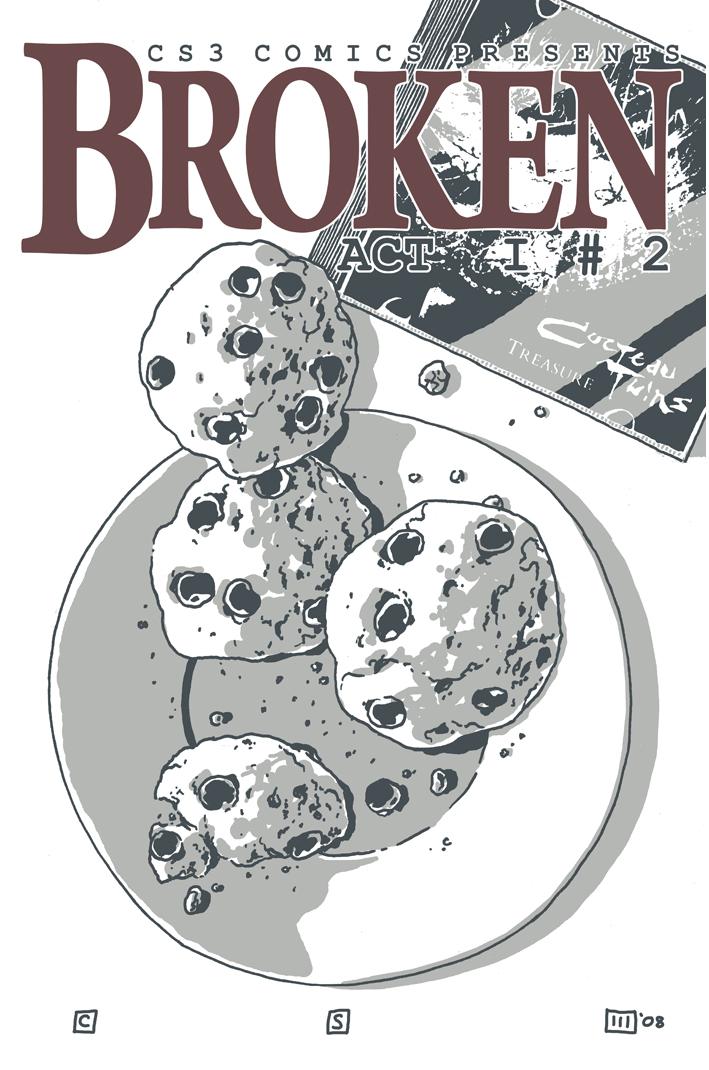 Writer/artist Chip Skelton knows how to pace a scene and also knows when the scene is interesting enough to slow it down and dissect it. Many of the panels provided are silent ones relying on the moody artwork to convey the message and mood. The thing that makes BROKEN THINGS stand out is the art. Skelton does a great job with a black and white palette (with the occasional red popping up sporadically). The simple, yet elegant lines add to the heavy tone.
Writer/artist Chip Skelton knows how to pace a scene and also knows when the scene is interesting enough to slow it down and dissect it. Many of the panels provided are silent ones relying on the moody artwork to convey the message and mood. The thing that makes BROKEN THINGS stand out is the art. Skelton does a great job with a black and white palette (with the occasional red popping up sporadically). The simple, yet elegant lines add to the heavy tone.Again, this isn’t a story that’ll make you want to skip in the park and pick daisies, but it will evoke emotion. This story slows down things and helps the reader appreciate the moments that all of us take for granted. In that, it is a truly special read and one to keep an eye out for as the story develops. So far, Skelton is into his second issue of the book, so it won’t take long for you to catch up to the present and enjoy each panel as it drops.
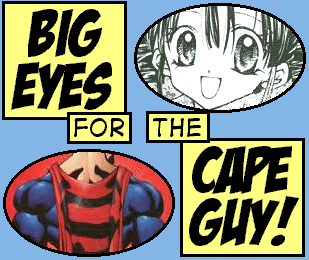
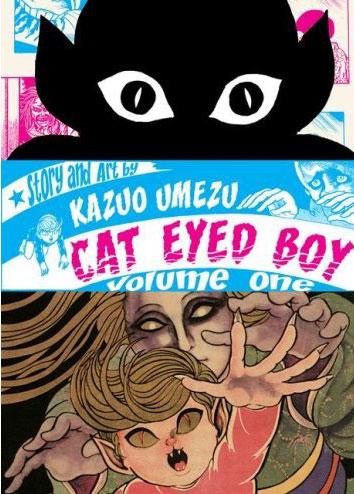
CAT EYED BOY VOL 1-2
by Kazuo Umezu Based on First 150 pages Volume 1 and Volume 2 to be Released by Viz Media on June 10, 2008 500 page collections retail for $24.99 Reviewer: Scott Green
For students of manga and or horror, CAT EYED BOY offers a compelling snapshot of an important stage in the development of popular Japanese horror, but for those not looking to collect a library of landmarks, be aware that beyond being a significant work, CAT EYED BOY is a raucous one. The passage of forty years has not dulled the threatening creepiness of Kazuo Umezu's world of lurking freaks and shadowy spirits.Given that, from the works of Takeshi Miike to MERMAID IN A MANHOLE, a thread of celebrated, or notorious, Japanese pop media is its shock films, if your interest in horror veers more towards cinematic works than sequential art, Umezu is still a figure to know in the genre. The "dead wet girl" subset of Japanese horror has theatrical underpinnings. The nexus in that thread is the Ghost Story of Yotsuya. This tale of a poisoned samurai wife who returns as a deformed creature with running hair and a white face was introduced as a kabuki play in 1825, and generated over 30 film adaptations, going as far back as 1912 and continuing as recently as 2002.
Alternatively, when a horror movie starts painting the walls red or tossing around internal organs, it is hard not to see inspiration by way of manga. This is not just due to the fact that people like Miike and Ataru Oikawa are frequently adapting from the medium. The mindset of capturing the world on a canvas that can be graphically warped and splattered upon feels very manga.
If Osamu Tezuka is the God of Manga, and Go Nagai is the crazy uncle who introduced piloted mecha and magical girls, Umezu is the elder prankster who unleashed the snapping dog that is horror manga. From Hideshi Hino's boils and puss to Junji Ito's pitched maddness, there are antecedents to the later greats of the tradition in Umezu's work.
David Hajdu's THE TEN-CENT PLAGUE is now widely popularizing a narrative of which students of American comics are very familiar. Targeting violent crime and horror comics, Fredric Wertham's SEDUCTION OF THE INNOCENT put a spike through the eye of the medium. After putting a muzzle on work like EC's horror anthologies, popular comics circled the wagons around a select few, safer genres, eventually narrow focusing around super heroes. To willfully ignore the underground comics movement for a moment, North American comics eventually produced WALKING DEAD and BLACK HOLE, but the Wertham movement marked a sort of mass extinction in the medium, after which decades passed before certain niches were repopulated.
In contrast to this de-clawing, Japan's manga tradition saw the rise of Kazuo Umezu. Born in 1936, Umezu began his career in 1955 with titles such as “Betsu-Sekai” (Another World) and “Mori-no-Kyoudai”. At the time, these where available through Kashi-hon, which were rented to manga readers. After working on sometimes risqué romantic comedies known as rabu-kome, he began working on horror manga, making a name for himself with traumatizing works like DRIFTING CLASSROOM and gag manga like MAKOTO-CHAN.
Umezu's shocking brand of horror did not arrive without precedence. In bringing his disturbing vision to manga, Umezu erected a particularly imposing gothic addition to the house built by Tezuka, but the fascination with the aberrant had already been a focus for Japanese media.
These parallels are always precarious, but Japan's Taisho period (1912-1926) can be compared to Germany's Weimar Republic. Both were marked by liberal democracy that eventually gave way to right wing militarism. One of the artistic movements of the Taisho era was "ero guro nansensu" or "erotic grotesque absurd/nonsense." It's a tradition that began with infamous ukiyo-e prints of unnatural acts or provocative mixes of sex and violence, and it continues today in confrontational veins of music or manga. In the late sixties, manga was hedging a bit in that direction. In 1967 Osamu Tezuka produced his proto-BLADE OF THE IMMORTAL, DORORO and KAZUO UMEZU produced CAT EYED BOY. As the barker proclamations of the rear cover for Viz's release of CAT EYED BOY indicate, the spirit might not be terribly ero, but its immensely guro-nansensu.
A chilling concoction of dark vignettes with the macabre, the grotesque and the absurd.
Hated by humans and demons alike, the cat eyed boy dwells in the shadows of the human world. No matter where he goes, terrifying situations involving humans and demons begin to unfurl.
Revenge! Obsession! Retribution!
 CAT EYED BOY, is the second earlist of Umezu's works to be released in English. The first to be released, was Viz's now out of print, volume long OROCHI: BLOOD, a gothic horror melodrama concerning sibling jealousy and an unaging girl, not unlike what is thought of as "J-horror." More recently, Viz has nearly completed their release of his 11 volume frenzied epic DRIFTING CLASSROOM, an experiment in extreme sociology with a school full of children stranded in a lethally barren, apocalyptic future. Perhaps the most relevant reference to CAT EYED BOY is his SCARY BOOKS. Three of its ten volumes where released in North America by Dark Horse before they halted the title. It was an anthology that would tell a pitch black, feudal tragedy, but more often had devilish fun recounting either gothic or frenzied school children tales.
CAT EYED BOY, is the second earlist of Umezu's works to be released in English. The first to be released, was Viz's now out of print, volume long OROCHI: BLOOD, a gothic horror melodrama concerning sibling jealousy and an unaging girl, not unlike what is thought of as "J-horror." More recently, Viz has nearly completed their release of his 11 volume frenzied epic DRIFTING CLASSROOM, an experiment in extreme sociology with a school full of children stranded in a lethally barren, apocalyptic future. Perhaps the most relevant reference to CAT EYED BOY is his SCARY BOOKS. Three of its ten volumes where released in North America by Dark Horse before they halted the title. It was an anthology that would tell a pitch black, feudal tragedy, but more often had devilish fun recounting either gothic or frenzied school children tales.CAT EYED BOY feels like an earlier work. The 1965 REPTILIA, released in North America by IDW is the early amphibian stage of the evolution between the Rabu-kome and what was to come, but CAT EYED BOY still seems raw, and openly experimental. Umezu was going wild in a new playground.
The manga offers an inclusive look at oddities and monstrosities. Opening on a creaky, mildew stained mansion, the manga closes in on the attic, then, on a pitch shadow in the attic, and in this shadow lurks a pair of cat eyes. When the view is eye ball to eyeball, laughter springs out of the darkness, and the Cat Eyed Boy introduces himself and addresses the reader as a co-conspirator. "Wherever I appear, something frightening happens. It must be that terror summons me. I hope nothing happens in this mansion."
This devil child offers a participatory point of view of events that trade on anxiety, repulsion and fascination. The perspective seeks out the weird and disturbing, as if the world was a rock that could be turned over in order to spy on the creepy crawlies underneath. And though the CAT EYED BOY is indomitable, beaten and berated, he continues to willfully endure, the manga pings the reader's uncertainty about their own monstrous nature. It plays to our fear that our parents aren't our parents, and rather than scientists from Krypton, our true parents are really menacing outcasts. It plays to our fear that our flaws are glaring, uncorrectable and ultimately fatal. For an older reader, and given the grisly imagery of the manga, most of its North American readers are going to be older, the nervousness and the excitement recalled by this mix amounts to a child-like but not juvenile experience.
In these early episodes, Umezu is a wobbly story teller. Narratives are more likely to carren into a development than gracefully build to one. He might present the points, but when connected, it's a herky-jerky arc. It's Umezu's illustrations that establish a absurd, grotesque world of strange dangers.
The three distinct stories in the available sample escalate from the simple to the elaborate. The simple is your standard issue ghoulish burnt man. In a FALLOUT (the PC games) sense, there is an ironic gap between the squared jawed productive members of society and this physically and ethically threatening lurker. Umezu understands the medium in which he's working, and he utilizes that understanding to build a presence for this sore thumb character. A regular, bright eyed boy is running through the rain for most of a page and in the last panel, over his shoulder, an arm reaches out with an umbrella. Flip the page, and there's a close up of the pealing skin, asymmetric jaw, and clenched fist of this menacing figure. The carnage is gruesome, but objectively, it's not anecdote worthy the way that MPD PSYCHO or DRIFTING CLASSROOM might be. There's no, "check out this manga, characters get eaten to the bone by tiny insects." Yet, given the way that Umezu captures this character pawing at windows with his bloody stumps, the lurker haunts the short story as a potent threat.
The bloody elevator of the CAT EYED BOY preview offered by Viz is THE TSUMNAMI SUMMONERS. In AICN fashion, first a gripe: Japanese folklore is populated by phone books worth of quasi-spirit creatures under the wide umbrella of yokai . This include horned brutes called oni, often translated as "goblin", "ogre", ect, turtle men with water carrying bowl heads called kappa, often translated as "water imps", long nosed, winged mountain spirits called tengu, "goblin"/"ogre" again, baka neko phantom cats, shape shifting foxes, shape shifting tanuki and on and on. In 2008, an anime/manga/Japanese media fan has seen all of these terms. To translate yokai as "goblins" in a work like CAT EYED BOY seems like a mistake. "Yokai" is mysterious and or it is an umbrella for this large cast of mythological beings. A "goblin" is a familiar, ugly half-person. The effect suggested by "yokai" is more suited to CAT EYED BOY than the effect raised by "goblin."
As that mini-rant indicated, The TSUNAMI SUMMONERS is Umezu's jaunt into the world of yokai. He sets it on one of those rural villages, locked against the sea by mountains. Utility poles are one of the few signs that the story is not set in pre-modern times. Here, he reveals the works of the yokai. Like putting a magnifying glass to pond water, the introduction of the right lens reveals a startling complex, bizarre, hidden world. Walking into the wrong forest clearing at the wrong time will put the unwary face to face with will-o-the-wisps, snake women, crawling heads, hags, apes with giant eyes for backs, and a whole dreamlike grotesque mimicry of humanity. It's Where the Wild Things drive you mad or call upon the forces of destruction to ruin you.
Umezu is not the only artist to pack a glen full of yokai. It's a familiar tableaux. What makes THE TSUMNAMI SUMMONERS potent, is the way that they crawl out of the darkness panel by panel, and that once they show themselves, they are revealed to be the sort of hideous, primordial menace that every child hopes was not hiding out of sight. Again, Umezu's command of the medium comes into play. He establishes a solid shape to these creatures with a dark outline. Then, there is always something that throws off the eyes beyond their unnatural shapes. This is either too chaotic, such as streams of hair, ripples of fat and wrinkles, knots of tentacles, or it is too intricately ordered, such as clothing or scales that repeat too much of a tightly interlinked repeated pattern.
Though THE TSUMNAMI SUMMONERS has a disturbingly cruel scene of impalement, the story demonstrates the primary nature of Umezu horror. Rather than being a gorehound, he's a prankster. He twists the manga form in one way or another, invariably bending it to a point where it will provoke a reaction.
Scott Green has been writing for AICN ANIME for close to seven years. If you like what you see here and love anime & manga, be sure to check out his latest AICN ANIME column here.
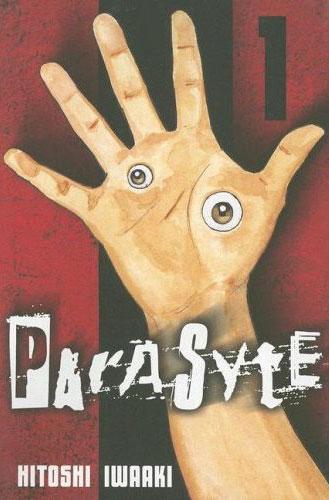
PARASYTE VOL 1-3
By Hitoshi Iwaaki Publisher: Del Rey Manga Reviewer: Scott Green
Hitoshi Iwaaki's PARASYTE thrives on not limiting the range of reactions that it evokes. Like AN AMERICAN WEREWOLF IN LONDON, it's disturbing and funny without contradicting the spirit on the work in either approach. Then, it finds works the fear of clearly mortal dangers against the classic tenants of a superhero story.The manga opens by arguing for a theory that life on Earth would be healthier if only the human population could be eliminated. It transitions to an aerial view of a densely settled community as a sprinkling of dandelion seed-like balls float to the ground, land, and sprout mollusk like feet. These extraterrestrial organisms, crawl into houses, into bedrooms, and slither into the ears of sleeping humans. Fortunately, teenage student Shinichi finds a way to thwart this invader: he fell asleep with his headphones on. Instead he finds that a lethal sentient being, rather than consuming his brain, buried itself into his hand. As an organism that is devoid of sentiment, Shinichi's hand-symbiot, dubbed Migi, can't see why it's host is so upset about others of its kind assuming human identities, then messily devouring unsuspecting victims. However, given that the creature needs its host for substance, and that its kind has no reservations against killing their own, Migi soon finds itself battling to protect Shinichi.
The people who, unlike Shinichi, had their brains successfully consumed become the hosts for the aliens. The heads of these hybrids can change shape to adopt different appearances or unravel to furl out a system of horrific bladed appendages and maws, which the aliens use to sustain themselves by devouring other humans. PARASYTE recognizes how unnatural some of this is and when it is not trying to be devastating, it frequently plays with the line between frightening and laughable. It never distracts from a moment that needs to be critically serious with an inserted joke, and it recognizes how to exploit the boundary between funny and unsettling.
Manga has a long standing tradition of mixing the superhero and horror genres, with the metaphors and concerns of a teenage superhero in the confrontational situations of horror. As with piloted giant robots, and transforming magical girls, the credit for establishing or popularizing the composite probably belongs to the crazy uncle of manga, GO NAGAI. Technically, it is a rework of his earlier DEMON LORD MAO DANTE, but the classic example of superhero horror manga is Nagai's DEVILMAN. Like MAO DANTE and many of the works that it inspired, DEVILMAN concerns a boy who merges with a demon in order to fight other monster.
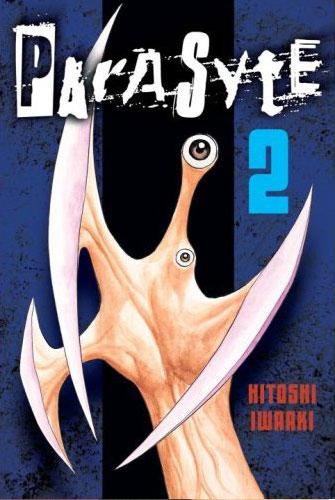 Given that it's Nagai, the manga starts with cthuhlu dinosaurs attacking hermaphrodite angels at the dawn of time, but after that, DEVILMAN opens with the buttoned up, proper young man hero's girlfriend giving him grief for his history of spinelessness. When a group of toughs confront that pair as they walk home from school, she's ready to scrap and he's the one who freezes. The volumes climaxes with the hero's alter go confronting she-demon with faces on its breasts in the midst of a booze and sexy fill club. Ultimately, he settles the fight by ripping his foes head off. All this in WEEKLY SHONEN MAGAZINE, an anthology with a younger audience than PARASYTE’s seinen anthology AFTERNOON.
The next day, the hero is again walking with his girlfriend. No longer a prissy student, he's shirtless with an open jacket. When the troublemakers turn up again, to his paramour's delight, he tells her to step back while he charges the knife wielding foes.
Given that it's Nagai, the manga starts with cthuhlu dinosaurs attacking hermaphrodite angels at the dawn of time, but after that, DEVILMAN opens with the buttoned up, proper young man hero's girlfriend giving him grief for his history of spinelessness. When a group of toughs confront that pair as they walk home from school, she's ready to scrap and he's the one who freezes. The volumes climaxes with the hero's alter go confronting she-demon with faces on its breasts in the midst of a booze and sexy fill club. Ultimately, he settles the fight by ripping his foes head off. All this in WEEKLY SHONEN MAGAZINE, an anthology with a younger audience than PARASYTE’s seinen anthology AFTERNOON.
The next day, the hero is again walking with his girlfriend. No longer a prissy student, he's shirtless with an open jacket. When the troublemakers turn up again, to his paramour's delight, he tells her to step back while he charges the knife wielding foes.PARASYTE works on the same naked coming-of-age metaphor. Its hero is confronted with the knowledge that he is no longer the sweet, innocent kid that he once was. Even if Shinichi can hide his physical alterations, his scars and what he's done to survive, the personal effects are evident. That raises the well founded concern that friends and family might not be able to accept what he has become. After Shinichi and his father experience one of the manga's irreversible acts of violence, the hero finds his father drinking in a dark room, where upon, his father remarks "When did you get to be so strong? Some times I wonder if you're made of iron."
Throughout PARASYTE, Iwaaki demonstrates an understanding of how to take genre convention and make the psychology behind those conventions provocative.
Though Shinichi is a normal looking guy, whose altered form is not nearly as flamboyant as something like DEVILMAN, on the psychological side of the superhero aspect to PARASYTE, Iwaaki works with the motivations and the personal toll on a hero the way that great writers of Spider-Man or Batman work with those characters.
The constant pressure to maintain secrecy and the constant battle-alertness might be specific worries for someone fighting a secret war against man-eating pod-people, but they also map to more universal experiences. There are parallels to be found in the need to be on guard in any daily routine.
As the manga has progressed, this attention to how the superhero experience effects Shinichi has made for compelling character development. Earlier the manga explored what it was like for Shinichi to find that his hand would sprout eyes and speak, that he could pluck a punch or a thrown rock out of the air, or he could hop over a wall. Three volumes in, the manga is dealing with what it is like for Shinichi to find that he become unphased by these abilities.
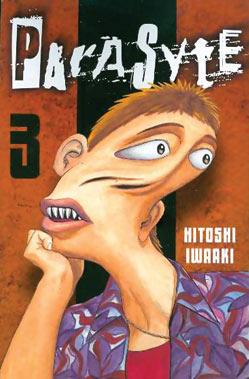 In the decades since DEVILMAN, anime and manga have offered many horror super heroes who were simply engaged in moonlight battles against creatures from the horror genre. What sets PARASYTE apart is that it solidly establishes its mortal stakes. In volume three, an alien possessed teen joins Shinichi, informing Shinichi that he's there to learn to discover a way by which the aliens could go-exist with humans. Later, the alien walks into the heart of the city, changes his face, then seduces a young woman... cut to a black, closed off corner where the alien has his shirt off while his alien-head has speared and begun to consume the naked body girl. When one of Shinichi's classmates finds herself face to face with this alien, given that the manga has displayed a willing to kill just about anyone short of Shinichi, the danger is palpable.
In the decades since DEVILMAN, anime and manga have offered many horror super heroes who were simply engaged in moonlight battles against creatures from the horror genre. What sets PARASYTE apart is that it solidly establishes its mortal stakes. In volume three, an alien possessed teen joins Shinichi, informing Shinichi that he's there to learn to discover a way by which the aliens could go-exist with humans. Later, the alien walks into the heart of the city, changes his face, then seduces a young woman... cut to a black, closed off corner where the alien has his shirt off while his alien-head has speared and begun to consume the naked body girl. When one of Shinichi's classmates finds herself face to face with this alien, given that the manga has displayed a willing to kill just about anyone short of Shinichi, the danger is palpable.As proper superhero horror, which engages both sides of that description, PARASYTE builds thrilling scenes that engage the gap between the two genres. The climax of volume three presents Shinichi in the midst of wall to wall carnage as he looks for is girlfriend. Looking to pluck his girlfriend out of harms way, he falls down in fear and disgust at seeing a hall full of what used to be schoolmates. Then, Shinichi takes a moment to suppress the natural human reaction, followed by a chilling scene of a composed Shinichi moving forward. Iwaakki demonstrates his skill at cartooning expressions and the power of the material in the minutia as Shinichi goes stone faced, and tries not to be drawn into the human details of the scenes, such as the tears in the eyes of a girl's severed head.

